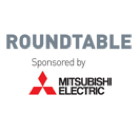Are you ready for the F-Gas Regulations?

The F-Gas Regulations are about to get much tougher as we move into 2018. Modern Building Services brought together a panel of industry experts to examine the issues facing the sector as gases such as R410A surge in price and R32 enters the UK market. Andrew Brister reports.
|
Who’s who on the panel Wayne Buckley – managing director, Temperature Control Seb Desmottes – head of product marketing, Mitsubishi Electric Carl Dickinson – product marketing manager, Mitsubishi Electric Graeme Fox – senior mechanical engineer, BESA Ray Gluckman – Gluckman Consulting |
Refrigerants in the building-services and air-conditioning sector have been a constantly moving target for decades. From the Montreal Protocol that phased out ozone-depleting CFC gases in the 1990s, through to HCFCs and on to the phase down of hydrofluorocarbons (HFCs) today, change has been the only constant. The industry needs to work tirelessly to stay abreast of legislation, advise clients and end users, bring new products to the market and install and service them.
The F-Gas Regulations, introduced to reduce F-Gas emissions by 79% between 2015 and 2030 by cutting the availability of HFCs with a high Global Warming Potential (GWP) enter the next, much tougher, phase in 2018. End users can expect big price rises and availability issues for industry stalwart gases such as R404A and R410A.
MBS brought together a panel of industry experts to examine the issues facing the sector, what alternative solutions are emerging, the benefits they offer, any installation and service challenges that contractors may face and the training and education required for a new breed of refrigerants.
In the new-build market, end users looking to meet their Corporate Social Responsibility (CSR) objectives are already seeking alternatives to air-conditioning systems containing refrigerants without a long-term future. In response to the Regulations and market demand, manufacturers are now supplying equipment that uses alternatives to existing refrigerants. Another alternative is to opt for systems which use a lower volume of refrigerant. The F-Gas Regulations also require stringent measures to be put in place to combat refrigerant leakage from air-conditioning systems.
 |
| Gluckman: There is a lot of progress in a number of sectors, but probably not enough |
Step change in 2018
Timing is crucial as the Regulations enter the next phase. “The key thing is that there is a massive step in 2018,” said refrigeration consultant Ray Gluckman. “The headline number is a 37% cut, though the real number is a 44% cut if you allow for imports of pre-charged equipment. This compares to a headline cut of 7% this year and last, so it is a massive difference.”
Gluckman has been working with EPEE, the European trade association of the refrigeration and air conditioning industry, on the so-called Gap-o-meter project, analysing what needs to be done to meet the phase-down timetable versus what is actually being done. “There is a lot of progress in a number of sectors, but probably not enough,” he said. “Until about three or four months ago the price signals for change weren’t there. Back in 2016, gases were still cheap and available. Suddenly that’s changing.”
The announcement by gas supplier Honeywell to stop selling R404A [a key gas in the supermarket refrigeration sector] from 2018 has forced prices up. “This has a huge bearing for specifiers of refrigeration equipment and prices for R410A are also shooting up,” said Graeme Fox, senior mechanical engineer at the Building Engineering Services Association (BESA). R410A is the gas typically used in split system and VRF air-conditioning systems in buildings.
New versus existing equipment
The Gap-o-meter project outlined by Gluckman analyses the actions required by the market in terms of: new equipment, existing equipment and recovery and reclamation of refrigerants. “In terms of existing equipment, end users are concerned that R410A will disappear,” said Wayne Buckley, managing director at contractor Temperature Control. “Many have made a recent investment in equipment and we need to get the message out there that we can maintain it and manufacturers will supply parts for the life of the equipment.”
 |
| Desmottes: goal is to have a common refrigerant |
Certainly, the F-Gas phase down allows for availability of gases for service, maintenance and repair of existing systems. “There’s enough headroom in the phase down to allow for that,” confirmed Gluckman. “What we don’t want to see is brand new systems using R404A.”
In terms of specification of new equipment that moves away from HFCs with a high GWP, the role of the manufacturer is crucial. R32 is the alternative refrigerant being used in new small split systems now available from manufacturers such as Mitsubishi Electric. R32 is being used instead of R410A. R32 has a GWP of 675, one third that of R410A which has a GWP of 2088. Larger chiller systems are seeing hydrofluoro-olefins (HFOs) being introduced, which have GWPs below 10.
“We’ve run a number of seminars this year for our end users about the F-Gas Regs, the challenges and opportunities behind it and the solutions available,” said Seb Desmottes, head of product marketing at Mitsubishi Electric. “Certainly, the much lower GWP of R32 is a massive driver for them and there is also around a 5% improvement in system efficiency over R410A.”
Safety first
The key issue exercising the minds of the industry is one of flammability. The likes of R32 are classified as mildly flammable and have been given a new category by US air conditioning body ASHRAE of A2L. This is a higher level of flammability than A1 refrigerants such as R410A, but much lower than A3 refrigerants such as propane (R290).
The Federation of Environmental Trade Associations (FETA) has issued a guidance note on A2L refrigerants. “In practical terms, it is very difficult to ignite 2L gases, but some precautions must be taken to prevent accidental build-up of refrigerant, particularly during charging of systems,” it states. “Manufacturers are suggesting that extract fans be used during this process, especially if the outdoor unit is in an enclosed area.”
While A2L refrigerants may be new to the UK and Europe, they are well established in other parts of the world. “There are already over 10 million split systems using R32 up and running in Japan,” said Carl Dickinson, product marketing manager at Mitsubishi Electric. “Europe is not going to be a test bed; it’s been well and truly field tested. We are very confident that what we’ve got in our technology, and the refrigerant, is going to be safe. I don’t think that’s going to be a challenge.” The panel agreed, but stressed that the correct procedures must be followed.
 |
| Buckley: The key point now is that we put R32 systems into the market with confidence. As a contractor, we wouldn’t be recommending something we didn’t have every confidence in |
EN 378 compliance
EN 378 is the generic safety standard that applies to air-conditioning equipment. It has been updated to recognise the use of A2L refrigerants, and gives charge limits based on three characteristics: refrigerant properties, access categories and location classification.
“We look at the application of A2L refrigerants in three stages – planning, installation and service and maintenance,” explained Wayne Buckley. “On planning, there are tables available from the manufacturers on the minimum room area required for a given gas charge and EN 378 compliance. There’s a lot of scaremongering about the installation, but if it is done properly according to the regulations, there is little difference. The only difference is when we introduce the refrigerant during commissioning; but if everything is done correctly with pressure testing and the pipework is safe, there should be no issues.”
The mild flammability is more of an issue during service and maintenance. “We have to use spark-free vacuum pumps and refrigerant-reclaim machines because of the concentration of gas in a small space, so there is an investment required there in terms of new reclaim equipment,” said Buckley. “Leak test and recovery tools do need replacing quite often anyway, so that’s more of an ongoing investment rather than a massive one-off cost.”
There may be advantages over R410A. “Reclaim and recycling should also be easier because R32 is a single gas, rather than a blend, and that helps with leakage too, because it leaks at one rate,” commented Carl Dickinson. “R32 is going to be good as a long-term solution.”
“The key point now is that we put R32 systems into the market with confidence,” said Buckley. “As a contractor, we wouldn’t be recommending something we didn’t have every confidence in. If it is applied correctly, there should be no risk, just in the same way that flammable refrigerants are used in domestic refrigerators.”
 |
| Dickinson: We are very confident that what we’ve got in our technology, and the refrigerant, is going to be safe. I don’t think that’s going to be a challenge |
Training and education
Graeme Fox raised the important issue of training. “Wayne is right and if best practice is followed there is no issue. A concern, however, is the number of operatives, some 28 to 29,000 in the UK, who don’t legally need any more training,” he said. In response, industry umbrella body ACRIB has called for mandatory training in A2L refrigerants. “The idea would be a half-day module that would give installers an awareness of the specific issues with the different classifications of refrigerants,” said Fox.
Manufacturers such as Mitsubishi Electric make it clear during training sessions that R32 is an A2L refrigerant. “It’s part and parcel of the course we run on our R32 equipment,” said Carl Dickinson. “We talk about what you should and shouldn’t do in terms of R32.”
Wayne Buckley thought the introduction of new refrigerants will have a positive impact. “Hopefully, it will improve the skill level in the industry. We will need to stop and think about what we are doing and how it is applied.”
What does the future hold?
Mitsubishi will make its HVRF hybrid of chiller and VRF technology available with R32 later this year. “R32 is not just a solution for splits. Our ultimate goal is to have a common refrigerant for all of our products,” said Seb Desmottes. “That will make life easier for our installers.”
A full VRF system running on R32 is still some way off as VRF applications use greater volumes of refrigerant. “EN 378 will need another revision before you will see R32 in VRF units,” commented Carl Dickinson. “We will get that once the industry has had a couple of years of experience of working with A2L refrigerants.”
No discussion on EU regulations is complete without mentioning Brexit. What can we expect to see in the future? “Crunch time for HFC availability is next year, while we are still in Europe,” explained Ray Gluckman. “The government is looking at all possibilities, and it is likely that we will retain something that is very similar to the F-Gas Regulations over the long term.”
 |
| Fox: training required on A2L refrigerants |
Graeme Fox agreed. “It is likely to be exactly the same for the foreseeable future. The only issue is the EU-wide quota which applies to the single market,” he said. “Does the quota stay at the same level with a percentage change to reflect that the UK will be outside of the EU? Or do the EU and UK work together to maintain the quota in the phase down?”
These Regulations are not going to disappear. Next year sees a massive step change in the allowed quotas of existing refrigerants which will undoubtedly concentrate minds on the future. “We have a responsibility as an industry to help promote this,” said Wayne Buckley. “Clearly we have to, we haven’t got any choice.”







